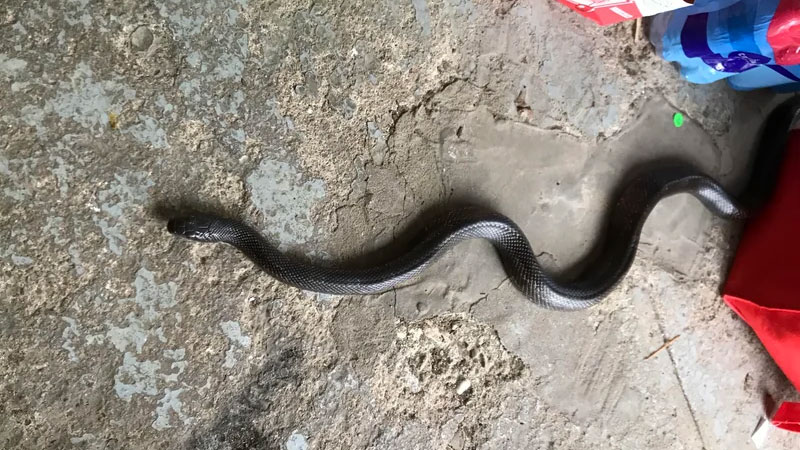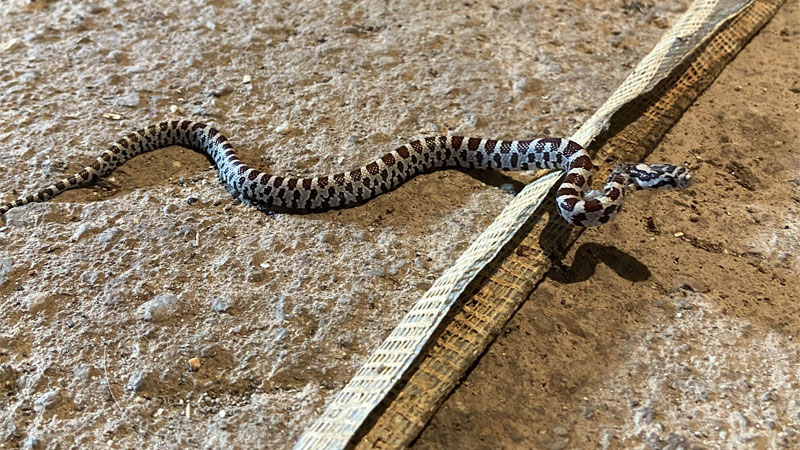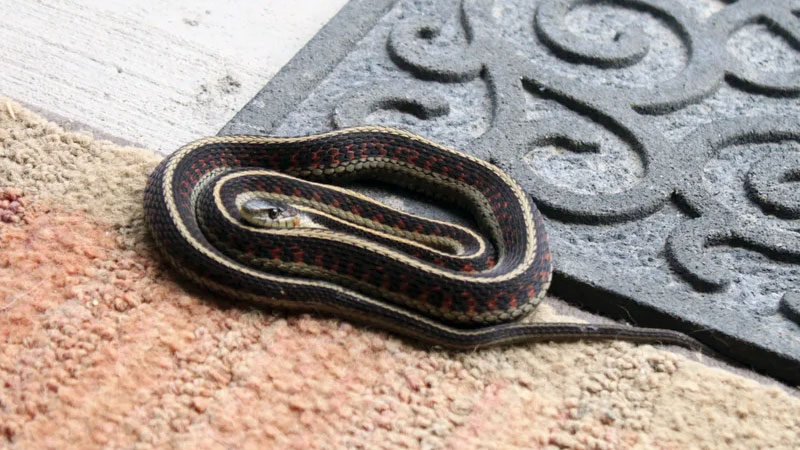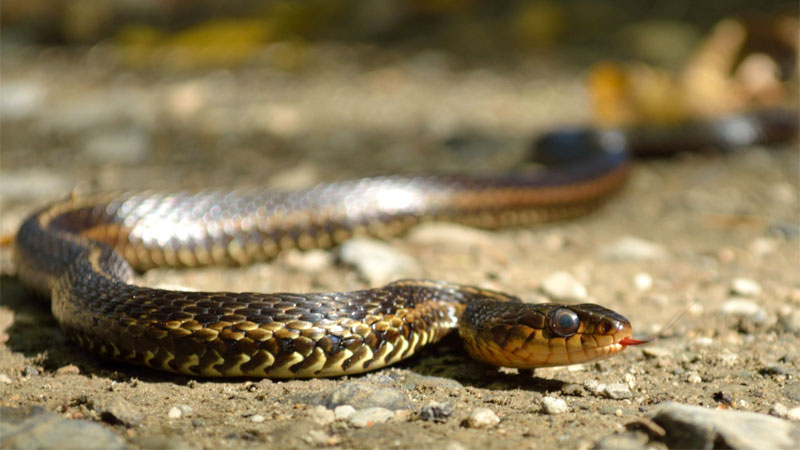After getting to the bottom of your basement stairs, being greeted by a slithering snake is not something you’d ever expect happening. But in some areas, it can. While your instinct may be to flee, take caution before reacting.
Should you discover a snake slinking around the depths of your home, don’t automatically assume burning down the house is your only option. Instead, resist panic and implement a safe capture strategy and/or contact appropriate removal assistance to extract the squatter. Here’s what to do.
Related: Animal in the Basement? (Here’s What It Could Be)
Assessing the Situation
Venomous vs Non-Venomous
Before doing anything else, try to identify whether the snake is venomous or non-venomous.
Venomous snakes, like rattlesnakes, copperheads, and cottonmouths to name a few, typically have some distinctive characteristics: a triangular-shaped head, elongated fangs, and slit like pupils that resemble cat’s eyes. Many also warn before attacking, like rattlesnakes shaking their signature tails.
Non-venomous snakes on the other hand, do not have heat-sensing pits between their nostrils and eyes. Garter snakes are by far the most common and they are completely harmless.
If you can’t get close enough (or don’t feel comfortable doing so), use your phone to zoom in and take a picture (try to include its head). Then use Google Lens or a snake identification app to help identify the snake.
Size
Next, determine the size and species of snake if possible. Use visual clues in your basement to estimate the length of the snake—is it a few inches or few feet long?
A tiny harmless garter snake invokes less urgency than encountering a timber rattlesnake. Identify unique features like color patterns, head shape, markings, body coil. For example, rattlesnakes often have a distinctive diamond shape marking on them.
If unable to identify species, err on the side of caution and presume the snake is venomous. But again, Google Lens or some type of snake identification app on your phone can be quite helpful.
Demeanor
Finally, assess the snake’s demeanor. Does it appear overly defensive or agitated, or is it remaining still hoping to avoid detection?
Greater caution should be taken if the snake seems aggressive in body language. Answering these key questions will determine the level of risk and next steps.
Initial Precautions
The first precaution upon spying a snake is to remain calm. Snakes do not wish to confront or attack humans, and given the opportunity will treat you the same way you treat them. Panicking causes erratic movements and vibrations which may prompt a frightened snake to defend itself.
Keep Your Distance
Next, keep a healthy distance between yourself and the serpent stowaway. If you have yet to spot the snake, observe areas where one may be hiding from afar before approaching. Have another person watch as you scan different vantage points.
Assemble Equipment
If you feel comfortable handling this on your own, gather any equipment that may aid in safe capture or removal while keeping vigilant watch.
Useful items include a long hook (like a poker stick from a fireplace), sturdy garbage can or bucket with lid, thick gloves or shovel, and flashlight if basement lighting is poor. These tools allow capture without direct hand contact.
Call For Backup When Needed
If at any point the snake shows signs of aggression, you are unable to identify species, or its size or positioning prevents safe access, call animal control services, wildlife removal professionals or emergency responders for assistance or extraction.
Venomous snakes especially warrant contacting experts to avoid tragic mishaps.
Capture Process
Strategic Approach
Once you have assessed the situation, taken initial precautions, and assembled necessary equipment, cautiously approach the area where the snake was spotted. Have your tools at the ready but avoid overly aggressive or hostile movements.
Read Also: Does a Snake Have a Backbone?
Guide into Container
Attempt to gently guide or let the snake move into a garbage can or bucket using a hook or shovel. Allow the snake to seemingly retreat into the container on its own rather than pinning it. Quick snatching motions may provoke biting or lunging in defense.
Secure Lid
When snake is positioned in can, slowly slide lid or garbage bag underneath opening to trap safely inside. Secure the lid while avoiding contact with the head or tail region. Lock lid in place with clamp, rope or weight. Carefully tape any other openings or edges through which snake could slither free.
Double Bag for Transport
For relocation, place securely closed can into one large plastic bag, remove excess air and tie end. Then insert bagged can into second bag as added backup in case of unlikely escape. Prepare makeshift “caution snake” sign for handlers.
Relocation
Temporary Containment
Once captured, the snake must be safely contained until wildlife authorities can retrieve it for relocation or proper removal. Place the sealed garbage can in a cool, secure area like a locked shed or garage away from human activity. Never transport in the passenger compartment of a vehicle.
Contact Wildlife Professionals
Locate your regional animal control office, wildlife removal company, or department of natural resources to arrange pick up of the contained snake. Most areas prohibit average individuals from personally relocating snakes further than 100 yards from point of capture. Let trained handlers determine appropriate habitat.
Follow Regulations
If transporting yourself, only release in designated reptile relocation areas following all rules, permitting procedures and ethical practices. Ensure you drive distance from the capture point and select spots with water, shelter and ample prey to increase relocation success.
Improper repositioning risks further conflict, property damage and survival challenges for the extracted snake.
How Do Snakes Get In a Basement?
Basements are usually thought of as the least pleasant area of a house—for humans. But not so in the eyes of a snake, and that’s partly why you may have snakes in the basement.
Impacted by habitat loss and attracted to suburban yards by the many prey animals feasting on pet food left outside, spilled birdseed, and unsecured trash, snakes naturally begin looking for nearby shelter, and often find ways into basements.
Food and shelter found together is a winning combination for any animal, and getting inside a home is relatively easy for a snake. Some only need an opening of 1/8 inch or so—that small an opening may be found around a basement window or door, around unsealed wires or pipe conduits, or in cracked cement steps or porch seams.
Exclusion: Keeping Snakes Out
Inspection
Search for cracks or holes 1/8 inch or larger at the foundation, examining cracks around basement windows and doors, unsealed wires or pipe conduits, and cracks in cement steps or along porches where they are attached to your home.
Sealing
After identifying all possible snake entrances, seal all but the one that seems most likely to be the main one, which is where you will attach a one-way door (described below). Use heavy-gauge wire mesh or match the original building materials.
After giving the snake a chance to exit by following the steps in “One-way door” (see below), seal the main hole as securely as the others.
One-way door
To make a one-way door for a snake to exit your home, roll a 10-inch-long piece of aluminum window screen into a cylinder. It should be a little wider in diameter than the main hole you have left open.
Insert one end and suspend the other end a few inches above the ground, which will enable the snake to safely exit, but not return. Leave the one-way door in place for one month before sealing the hole, or until late spring if it is already fall.
Prevention
Don’t forget to assess your yard for things that may have attracted the snake.
- Are there hiding places for snakes and their prey, such as piles of debris, rocks, or wood?
- Are there cracks in cement porches or walks, or access to space under a shed floor?
- Is pet food left out, spilled birdseed left on the ground, or garbage left unsecured?
Things that attract prey animals make your yard an appealing place for snakes to hunt and your home a convenient place to seek shelter. Reduce your yard’s appeal to snakes and you’ll reduce the likelihood of snakes entering your home.
- How to Identify Skunk Poop (With Pictures) - April 1, 2024
- You Really Don’t Need That Opossum Trap - January 4, 2024
- How to Set a Mouse Trap Without Getting Hurt - December 28, 2023




